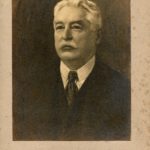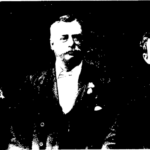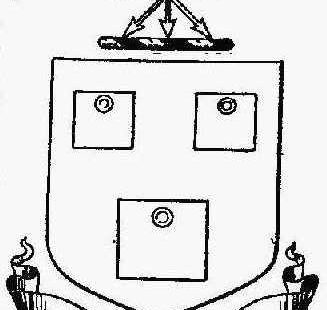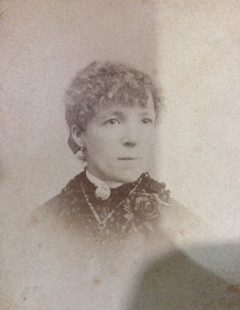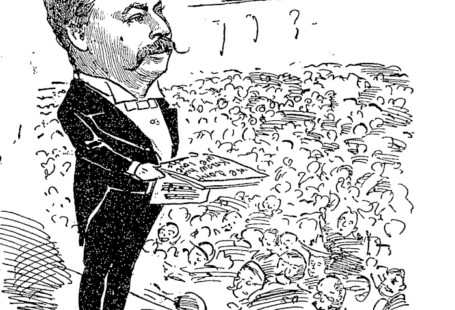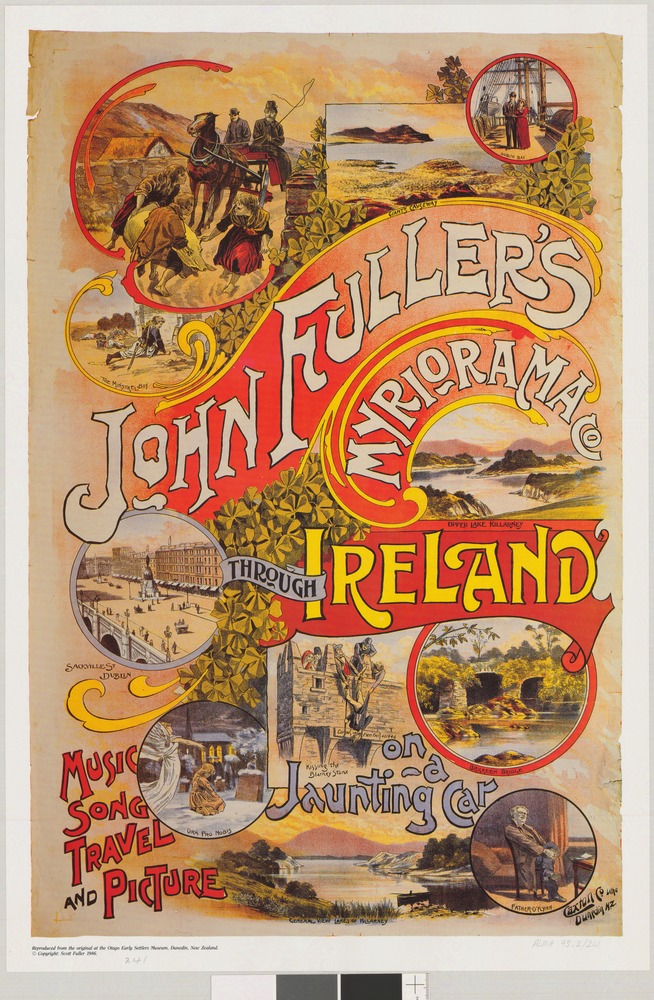
John Fuller’s Myriorama Through Ireland on a Jaunting Car, image courtesy of Australian National Library Collection, originally printed in Dunedin, New Zealand, by Caxton and Co
1895 was the year when the rest of John Fuller’s children, Walter, Benjamin and Lydia arrived in Auckland, New Zealand for the family reunion that John Fuller Snr had so anticipated and longed for.
Early in 1895 John Fuller went on tour to Australia with The Continentals, visiting both Adelaide and Melbourne.
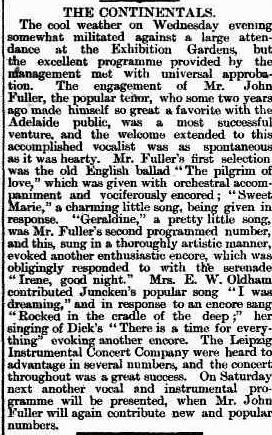
Express and Telegraph, (Adelaide) 7 February 1895
The Auckland Quiz, that same morning stated“With the Continentals was Mr. John Fuller, a tenor who has deservedly made himself very popular in Adelaide, and is now on a visit from Auckland, where he has made a very high reputation. Mr. Fuller’s voice has lost none of its sweetness and he was received with demonstration of applause on Wednesday night.”

The South Australian Register 16 February 1895
Touring in Adelaide with the Continentals, John Fuller’s songs are Sweet Marie and Only Once More as well as the duet, In the Dusk of the Twilight with Mrs. E. W. Oldham, a contralto.

Express and Telegraph (Adelaide) 20 February 1895
In John Fuller’s farewell concert with the Continentals, he sings The Anchor’s Weighed and Let me like a Soldier Fall as well as a duet with Mr. Julian O’Sullivan called The Fisherman.
As can be seen from the previous newspaper clippings, the show must go on, and when John was not producing his Peoples Popular Concerts in Auckland, he was taking work with other companies, which paid him well. He got all his expenses paid, plus 3 guineas for each show.
While impatiently waiting for the arrival of Ben, John took the opportunity to travel with The Continentals to Adelaide, and if family stories are correct John and Ben met down on the docks when Ben arrived aboard the Austral. The Austral had already called in at Adelaide so this family reunion may have taken place in either city. Later I found that John Fuller was appearing in a Harry Rickards Production at the Melbourne Opera House, no doubt filling in time till Ben arrived, which was reviewed by The Melbourne Age on 25 February 1895, newspaper article illustrated below.
Alistair Duncan tells this marvellous story in Actor’s Blood:
“It has been recorded in print several times as fact that Ben met his father by the merest chance on disembarking at Port Melbourne. If so, then possibly John had come to Melbourne on some business arising from his company management job in Adelaide, and happened to be strolling along the wharf when Ben, having clambered down the gang plank from “SS Austral”, spotted him. Or John spotted Ben, or they passed each other and then went into two gigantic double takes.
Of course, Ben could have let his father know his arrival date and time and John could have come to Melbourne to especially meet him. What gives the chance encounter story some credence is the “Austral” would have called in at Adelaide en route to Melbourne and John could have met his son there, but by then he might already have had to leave for Melbourne on business. There are dozens of permutations and combinations possible – but without any doubt, if asked, the Fullers would have sworn by the accidental meeting. Like the River Lee rescue of the singing teacher, it plays well.
One thing John would certainly have mentioned to Ben was that he had sent home his passage money to Australia, not realizing that he was already on his way out. Now no longer needed by Ben it could be made available to Walter or Lydia. When John’s Adelaide job ended and the time came to put out a call for the family to assemble in Auckland, with any luck the reunion could be complete in a matter of months.”
Readers will see a slight divergence of fact and fiction, however this was the way John Snr liked to remember the facts!
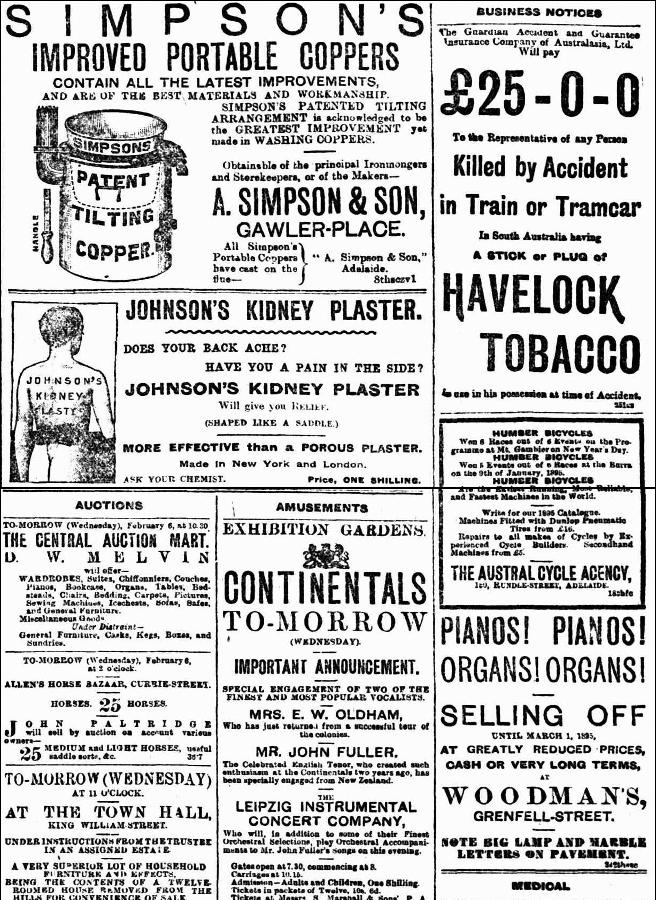
The Evening Journal, Adelaide, 5 February 1895
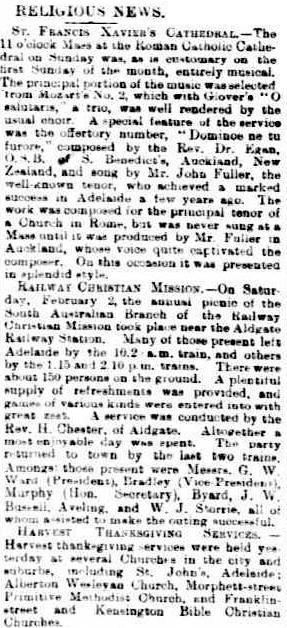
Religious News Adelaide, 5 February 1895
As can be seen from this newspaper article, John loved to sing in churches and cathedrals, clearly something that he had loved dearly as a youth. I am sure he discovered his silvery tenor voice singing in the churches of Shoreditch, London.
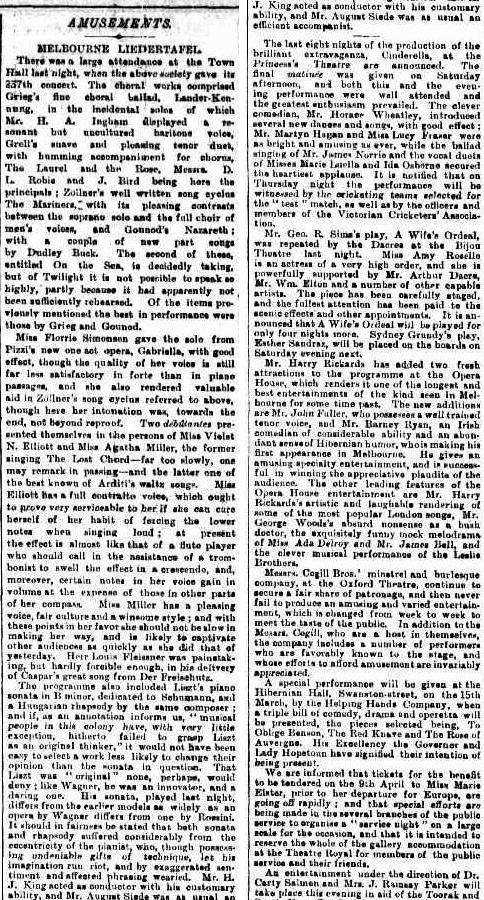
The Melbourne Age, 25 February 1895.
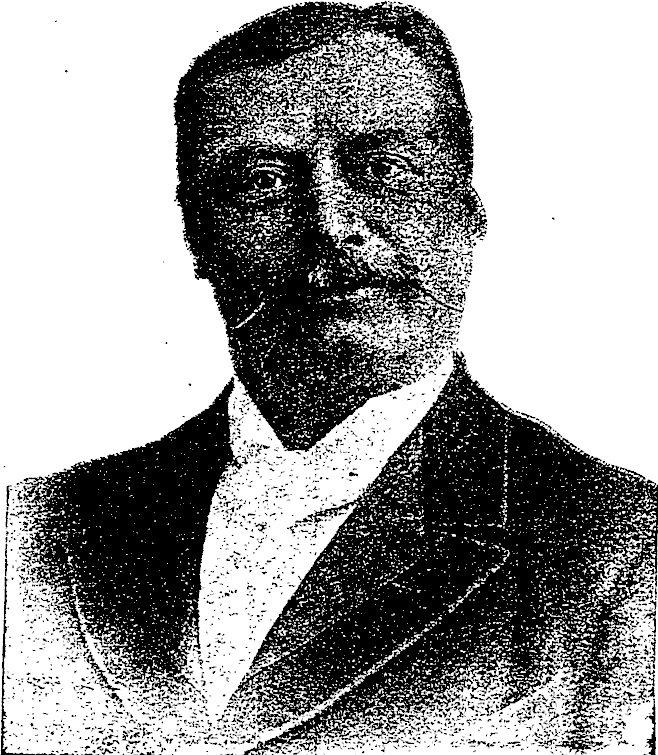
Photo of John Fuller, courtesy of Auckland Observer, 15 June 1895
I captured several articles regarding the arrival of The Austral into Australian waters, whilst none mention Ben Fuller by name; the ship’s arrival dates support the family story about Ben Fuller’s arrival in Australia.
It would seem that the Melbourne date fits better than the Adelaide date of 19 February 1895 to celebrate the reunion on the dock of John and Ben Fuller. I feel I can confidently confirm that John Fuller and his son Ben met up in Melbourne on 22 February 1895 and then they travelled to Auckland together after John’s contract with Harry Rickards was finished in early March of 1895.
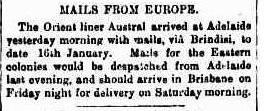
South Australian Register 20 February 1895
The arrival of Ben Fuller aboard the Austral, Adelaide, 19 February 1895, however, he did not disembark until the port of Melbourne until 22 February 1895.
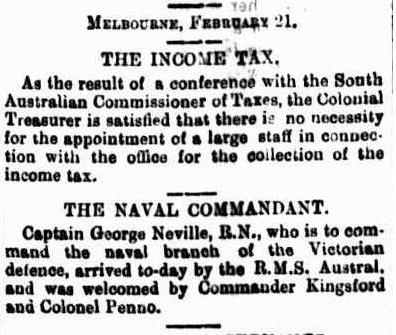
Brisbane Courier, 22 February 1895
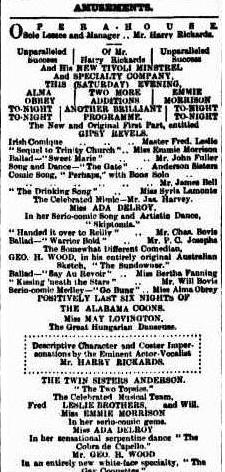
The Argus, 2 March 1895
This advertisement from 2 March 1895 finds John Fuller still in Melbourne, performing in Harry Rickard’s New Tivoli Minstrel Show, singing a favourite balled, Sweet Marie. Others in the company were dancers Miss Ada D’Elroy and Miss May Lovington and singers, The Twin Sisters Anderson, The Leslie Brothers, Miss Emmie Morrison, Mr. P. C. Josephs, Mr. Harry Rickards and comedians Mr. George H. Wood and James Bell.

Table Talk, 1 March 1895

Auckland Quiz and Lantern, 4 April 1895
This next advertisement from the Auckland Starmarks the return of John Fuller’s Popular People’s Concerts at the City Hall with John Fuller singing, Sweet Marieand Baby,stating that these two popular songs are the rage in American and Australia. He also sings a duet I’ve Wandered in Dreamswith Miss Katie Fitzpatrick. It also marks the first appearance of Mr. Ben Fuller, the young English pianist, humorous vocalist and monologue entertainer when he presented Mrs. Brown Smith’s Evening Party and The Stammering Sweetheart. John and Ben sing a trio with Archdale Tayler, Gypsies Laughing Trioand in a quirk of fate, Miss Lily Thomson, Ben Fuller’s future wife also appears singing Rouquetiereand Leonore. A flute solo by Mr. George Haswell was highly received.

The Auckland Star 6 April 1895

The Auckland Star 9 April 1895
In April the Auckland Star on 6 April 1895 reports that Ben Fuller makes his first appearance on the stage in Auckland, being described as “the Young English Pianist, Humorous Vocalist and Monologue Entertainer”, and he was reviewed by the same newspaper on 9 April 1895.
In a most interesting quirk of fate, in this first performance, Ben appears with his future wife, Lily Thomson.
Young Johnny is noticeably missing from this third Peoples Popular Concert performers that John Fuller was producing. No doubt Johnny was working backstage with the organisation of the Concert. Quick to recognise Ben Fuller’s arrival in Auckland, the next advertisement for the People’s Popular Concerts extolls Ben’s enormous success. It is probable that Master Johnny Fuller’s voice has now broken and he is resting his voice. It is possible of course that Johnny Fuller may have returned to his schooling to complete some formal education.
As a matter of complete coincidence, I was tidying up my mother’s photograph and placing them into a spot when I opened an old Fuller family album. It was at the time I was updating this chapter and to my delight I saw a photograph of a school stating that Johnny attended Grafton School in Auckland in 1894.

Grafton School, Auckland, where John Fuller went in 1894, photograph of Mr. Saunders and my mother, Vena Robson nee Fuller, circa 1950

The Observer 13 April 1895

Thames Star, 16 April 1895
Performing at St George’s Hall, Thames, on 15 April 1895 was opened by Miss Lily Thomson who played Polish Dance on the pianoforte, followed by singers Archdale Taylor and Katie Fitzpatrick. John Fuller sang Sweet Marie and Say Au Revoir and a duet with Katie Fitzpatrick I’ve Wandered in Dreams. Lily Thomson appeared again singing Bouquetiere and encored with Castanetta. Ben Fuller presented his comic monologue Mrs Brown-Smith’s Evening Party. Second half performances were Lily Thomason on the piano playing Gique and Ben Fuller singing The Stammering Sweetheart. The audience had earlier called for John Fuller to sing Geraldine and he appeared again to satisfy his audience with this favourite song as well as singing the lullaby Baby. Miss Thomson encored with Leonore. The Thames Star reported that “the musical part of the entertainment was brought to a close with “The Gipsies’ Laughing Chorus” by Messrs. John and Ben Fuller and A. Taylor.”
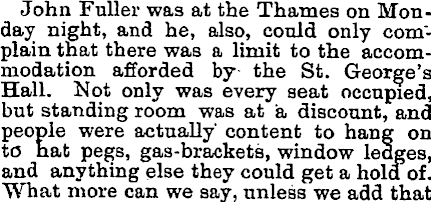
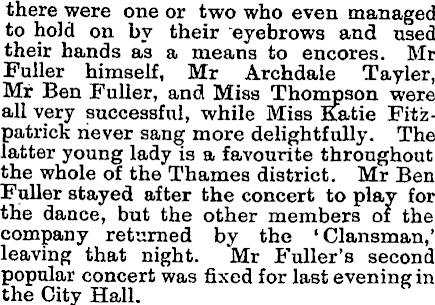
The Observer, 20 April 1895
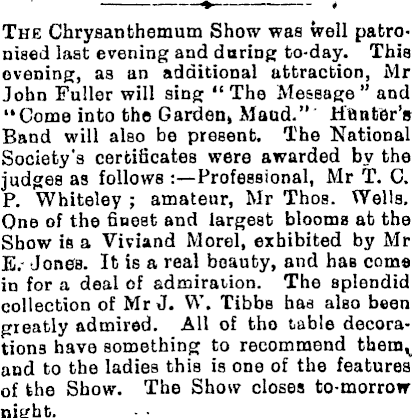
The Auckland Star, 19 April 1895
As always John Fuller had a voice for hire, and this advertisement shows his willingness to perform for his public and do favours, where possible, for his fans. These solo gigs were all part of John’s clever publicity machine that kept him in the public eye and would have helped promote his own productions.
As an additional attraction in the evening at the Chrystanthemum Show in Auckland, John Fuller, sings The Message and Come into the Garden Maud.
By the end of the April 1895, both Lydia and Walter have arrived to complete the reunion.

The Auckland Star, 26 April 1895
I was lucky enough to find the ship that Walter and Lydia Fuller arrived on the ship, Kaikoura from London, when I narrowed down the parameters of Paper’s Past, New Zealand’s online old newspaper website.
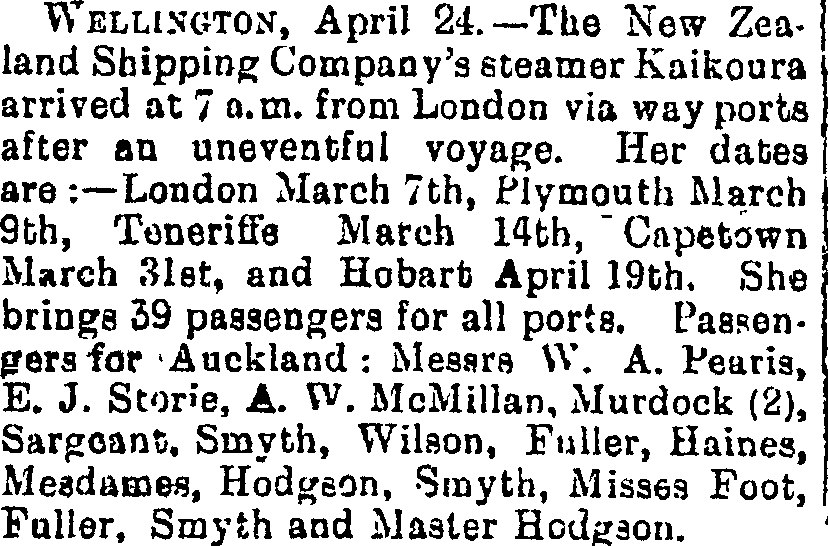
Arrival in Auckland of Walter Fuller and Lydia Fuller, aboard the Kaikoura, The Star, 24 April 1895
To mark the Fuller family reunion John Fuller had a photographic session to record the family all gathering in Auckland. It must have been so exciting for Walter, Ben and Lydia to meet their new sister May. At the same time, John makes plans to launch the New Zealand careers of Walter and Lydia.
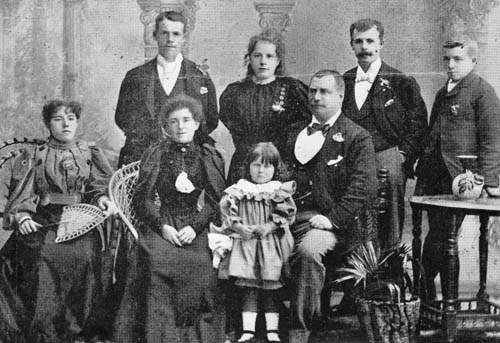
The Fuller Family Photo, Auckland, New Zealand, 1895 image courtesy of Scott Fuller
Back L to R: Walter, Hettie, Ben and Johnny Fuller, Front: Lydia, Ma, May and John Fuller
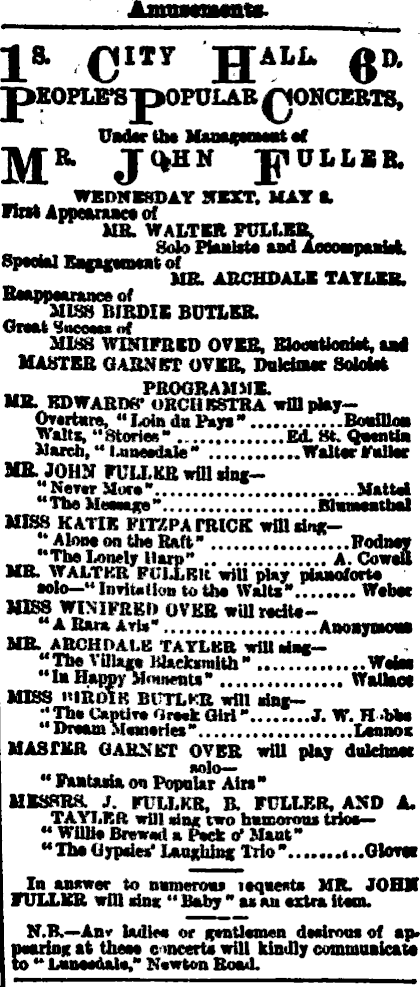
New Zealand Herald, 7 May 1895
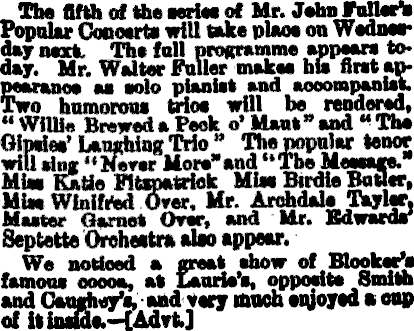
New Zealand Herald 7 May 1895
Mr. Walter Fuller makes his first appearance as a solo pianiste and accompanist along with the special engagement of Mr. Archdale Taylor and the reappearance of Miss Birdie Butler in John Fuller’s Popular People’s Concerts. John Fuller sang, Never More by Tito Mattel and The Message by Blumenthal.
Other members of the company were Miss Katie Fitzpatrick, Miss Winifred Over, Master Garnet Over and Mr. Edward’s Septette Orchestra. John Fuller, Ben Fuller and Archdale Taylor sang two trios Willie Brew’d a Peck o’ Maut and The Gypsies Laughing Trio.
On the 17 May 1895 John Fuller’s People’s Popular Concerts featured Walter Fuller playing the mandolin solo, Cavatina, John Fuller sang Come into the Garden Maud and My Pretty Jane and the duet In the Dusk of the Twilight with Miss Katie Fitzpatrick, who also sang solos, Alone on the Raft and the Good and the New. Lydia Fuller sang Esmerelda and Ruby while Ben Fuller sang the comedic song, The Grass Widower and The Nice Old Maid.
On this occasion it was John, Ben and Walter Fuller who then sang the humorous trio, Willie Brew’d a Peck o’ Maut.
The concert was concluded with John, Ben and Lydia presenting Offenbach’s One Act Comic Opera, The Rose of Auvergne.

The Thames Star 17 May 1895
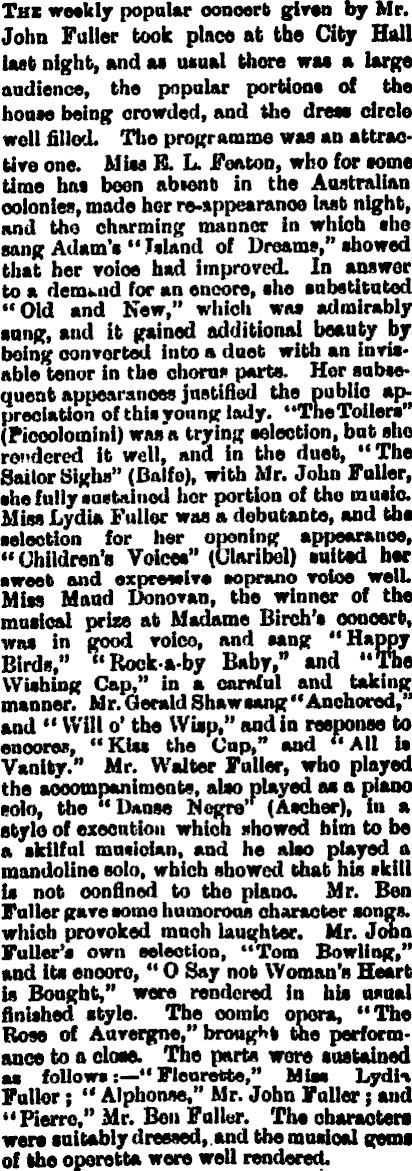
New Zealand Herald, 30 May 1895
John Fuller was a busy man, recruiting new acts, singers and devising new programs for his Concerts. The introduction of a finale operetta, The Rose of Auvergne was an instant hit. The Thames Star advertisement of 17 May 1895 and a review from the New Zealand Herald, 30 May 1895, mentioning John and his children, Walter, Ben and Lydia. However, Hettie is yet to make an appearance, and Johnny is probably working on the production side, physically just waiting in the wings for his adult voice to mature.
Once the Company has exhausted its audiences in Auckland, John then takes the show on the road, including his children Ben, Walter and Lydia. They head for the Taranaki area which is on the south-western side of the North Island an area John Fuller has not been to before. John Fuller, the popular tenor, singing The Dear Old Home and Take a Pair of Sparkling Eyes.
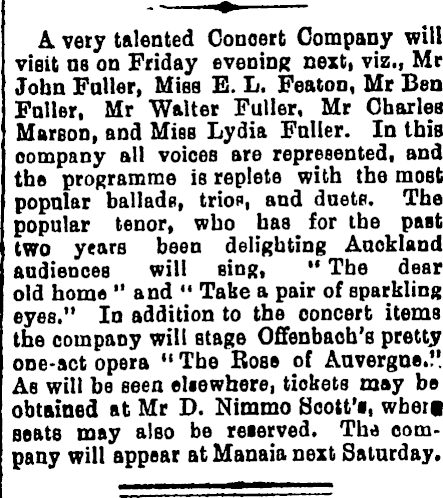
Hawera Star 22 June 1895
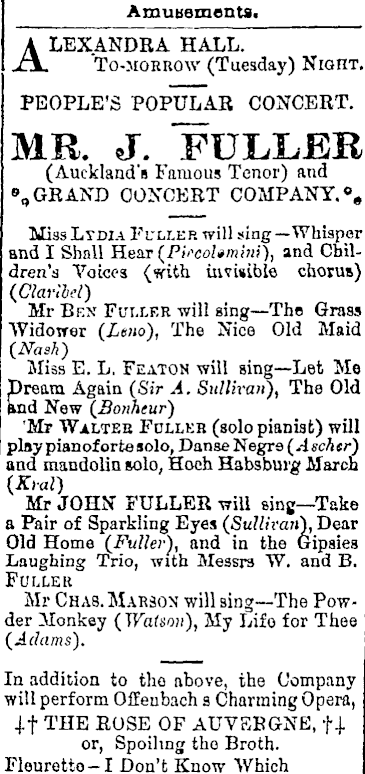
The Taranaki Herald 24 June 1895
Lydia Fuller sings Whisper and I Shall Hearand Children’s Voices, Ben Fuller sings The Grass Widowerand The Nice Old Maid, Miss E. L. Featon sings Let me Dream Againand The Old and the New, Walter Fuller plays the piano and mandolin, John Fuller sings Take a Pair of Sparkling Eyes, Dear Old Homeand The Gipsies (sic) Laughing Trio with Walter and Ben Fuller and Mr. Charles Marson sings The Powder Monkey and My Life for Thee, for Mr. J. Fuller, Auckland’s Famous Tenor.
This advertisement placed in The Taranaki Herald 24 June 1895 shows John is hiring the Alexandra Hall in New Plymouth for his concerts.
The Fuller family returns to Auckland for another series of concerts in July. Master John Fuller is back, this time as a reciter, and I can see that his father John is working on a routine to get Johnny regularly appearing in his Company.
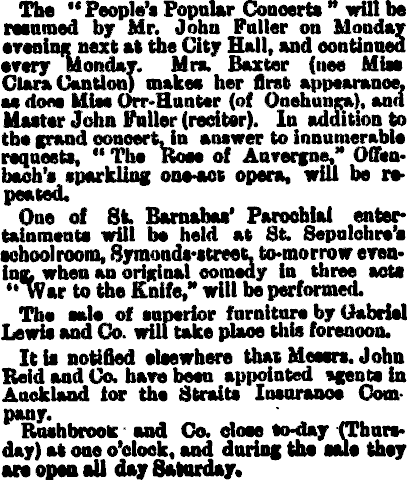
The New Zealand Herald 4 July 1895
The People’s Popular Concerts resume in Auckland and Mrs. Baxter, nee Miss Clara Cantlon maker her first appearance as does Miss Orr-Hunter of Onehunga and Master John Fuller is back as a reciter. “After innumerable requests, “The Rose of Auvergne”, Offenbach’s sparking one-act opera will be repeated.” New Zealand Herald, 4 July 1895.

The New Zealand Herald, 9 July 1895
On 8 July 1895 the Fuller’s People’s Popular Concerts was again very successful. John Fuller sang I seek for thee in every Flower, Mona and Alice Where Art Thou, and encored with There is a Flower that Bloometh. Mrs. Baxter, a mezzo soprano sang Call Me Back and The Cows are in the Corn, encoring with Pierrot and Robin Adair. Minnie Orr-Hunter sang Mignonette and When the Tide comes in as well as a duet with John Fuller, The Sailor Sighs. Mr. Reginald Burch was encored for the Charmed Cupin response to his song In Venice.
A review of the previous night’s concert at the City Hall in Auckland, when Master John Fuller scored a hit with his comedy recital of The Fireman’s Wedding.
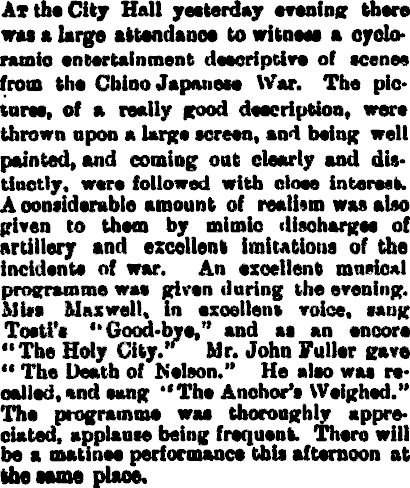
The New Zealand Herald 13 July 1895
This newspaper clipping mentions cycloramic entertainment, and for the first time it is clear that they are using myrioramic effects during the first part of the evening, later the Fullers present their musical programme. Clearly all the Fullers are happy with the compromise in their business, and clearly it is a good formula. John Fuller sang The Death of Nelson and The Anchor’s Weighed.

The Bay of Plenty Times, 9 September 1895
John is singing with another company at a Grand Concert in Tauranga, a town on the Bay of Plenty, on New Zealand’s North Island. It must have been an impressive venue because the following month John Fuller takes his talented family to Tauranga, where he hires the Theatre Royal, for his newly formed Grand Auckland Concert Company.
Supporting singers with the Grand Concert are Mr. Garland, Miss Snodgrass, Mr. Johnston, Mrs. Perry, Mr .F. Bull, Mrs. Frazer, Mr G.A. Ward, Mr. T. W. Watts, a comic comedian, Miss E Winter, Mrs. De Bourbel and the Misses Brabant.

New Zealand Herald, 13 November 1895

The Observer 16 November 1895
This incredible advertisement gives so much information about the Fuller family and one has to marvel at the itinerary town names where they are to tour. We can now see that Hettie Fuller has joined the Talented Family’s Northern Tour. For the very first time the entire family, John Fuller Snr., Walter Fuller, Ben Fuller, Hettie Fuller, Lydia Fuller and John Fuller Jnr. are now on the stage in New Zealand. Also John is doing well enough to have employed E. Nordon as his Business Representative, he now has an agent who is looking out for opportunities for the family business.
It must have been a very Happy Christmas in the Fuller household that year and I am sure they must have toasted their early success and wished each other more triumphs in the following year. John had made some interesting plans for the Fuller family entertainment business.

The Bay of Plenty Times, 21 February 1896
The Bay of Plenty Times, 21 February 1896, shows where the family are on the road again singing at the Theatre Royal at Tauranga, a town only about a two-hour train ride south from Auckland. This notice in the New Zealand Herald is part of the magic that John Fuller weaves and his knack of achieving publicity for his business in about to become legendary.
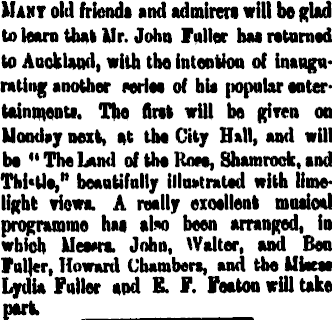
New Zealand Herald 14 March 1896
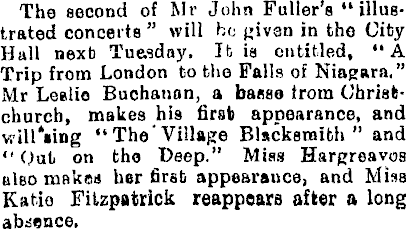
The Auckland Star 20 March 1896
It is interesting that the reviewers have still not settled on a name for the Fuller’s “illustrated concerts”, they are without a doubt using the Myriorama machine that was hired from the Sydney School of Arts, with Johnny Fuller working the machine, the show was entitled A Trip from London to the Falls of Niagara.
A MUSICAL TREAT
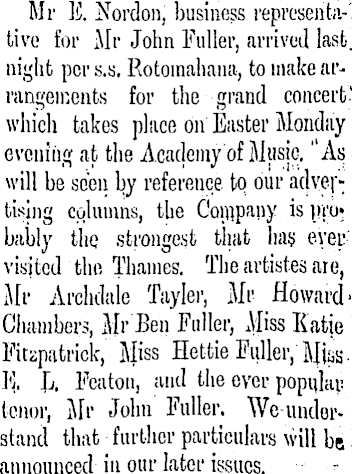
The Thames Advertiser, 31 March 1896
Thames is a town just south of Auckland and a favourite one on John Fuller’s Popular Concert tours.
Whilst Ben and Walter had stayed in England during the period when John Fuller toured Australia and New Zealand, the two brothers had the good fortune to be employed by Poole’s Myriorama Company. Walter was conducting the music and Ben was employed to their publicity department, which actually meant bill sticking and circulating leaflets. The two men had learned pretty well everything there was to be known about the business. They both felt that the Fullers entertainment business could be complemented with a show. It would appear that they managed to procure a machine from the Sydney College of the Arts, on a hire basis with the understanding that it would be returned when needed to Sydney. The Sydney machine was called an Electrinopticon Lantern complete with a variety of interesting slides, mainly English, Irish, European and African historical and geographical scenes. They developed a theme for the slides and several shows were invented.
There had apparently been a family vote regarding the move to a change in the Fuller business in 1896. John Fuller was happy with the status quo; his sons however, felt the need for modernisation. John’s company was making money, but only just breaking even, some Concerts saw a hefty profit, and others were less successful and profits were gobbled up with these losses. The household laughed, some nights it was soup for dinner, others nights it was roast chicken!
The vote was taken, the decision was made, and it would need to raise extra money to start the enterprise, as hiring a machine was not without expense. It was also decided that Ben would continue his job as marketing and publicity manager, Walter would be the vocalist who described each scene, and it fell to Johnny to become the controller of the electrinopticon lantern, and handle the slides and at the same time organise the off stage sound effects and lighting.
Patrons were to be treated to the wonders of scenes from the other side of the world, bought to life in the theatres of New Zealand. Many citizens had been born in New Zealand and had only read books and seen illustrations about Europe, Asia and Africa. This curiosity for the past and all things from the other side of the world was about to strike pay dirt for the Fuller family who had come up with a popular way of combining John Fullers vaudeville with his son’s spectacular Myriorama shows. It was a matter of being in the right place at the right time with the right equipment. The New Zealanders loved it, and they flocked to the theatre time and again as new shows were mounted. The formula worked and now Ben Fuller was on the verge of travelling back to England, purchasing a machine and more slide shows to quench the thirst of the New Zealand populace.
John Fuller’s Auckland Concert on 23 June 1896 attracted a huge crowd with many patrons content to stand in the passages of the dress circle and stalls throughout the whole performance. The AucklandStar stated that “the pictures were thrown on the screen by aid of a lantern from the Sydney School of Arts, lately purchased by Mr. Fuller.”Effects included a visual “trip” to London via San Francisco. Entertainers included Harold Batger’s first appearance as well as Miss Katie Fitzpatrick, Archdale Taylor and Master Norman Warren. John Fuller contributed Oh Don’t you Remember Sweet Alice, Ben Bolt andWhen Other Lips.
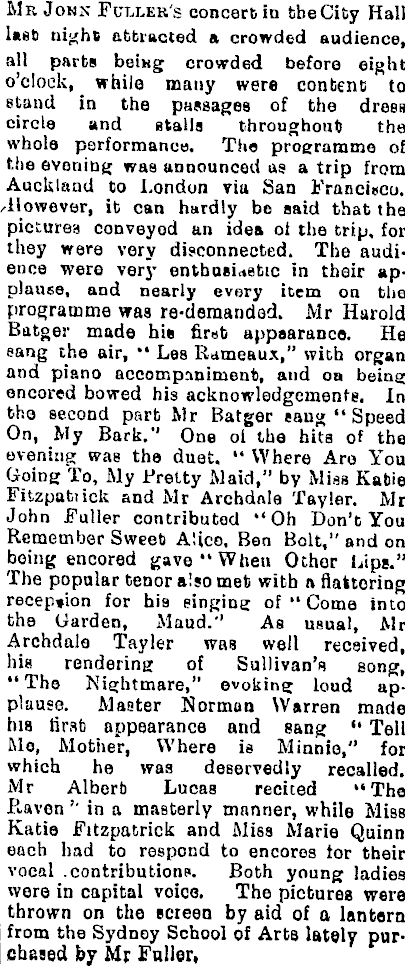
Auckland Star, 24 June 1896
The lantern from the Sydney School of the Arts is mentioned in the Auckland Star, 24 June 1896. Whether it was a purchased or was a loan is questionable, however, I am sure John Fuller felt that the mention of such a scientific machine borrowed from Sydney was a matter that would impress the New Zealand public, and as with all things scientific, there was considerable interest in these new contraptions.
This next advertisement on 27 June 1896 from The Observer newspaper includes a new title, “Mr. John Fuller’s Grand Limelight Concert” for his production which includes “The New Triunial Lantern” taking the audience from London to Auckland via the Suez Canal and Australia.
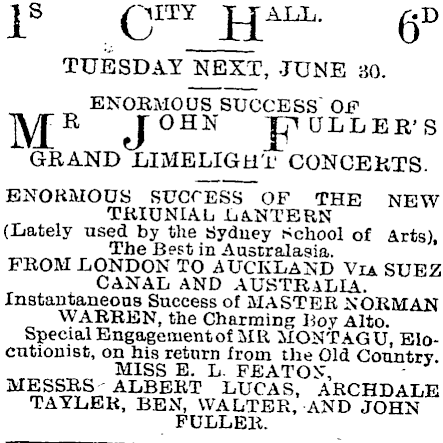
The Observer, 27 June 1896
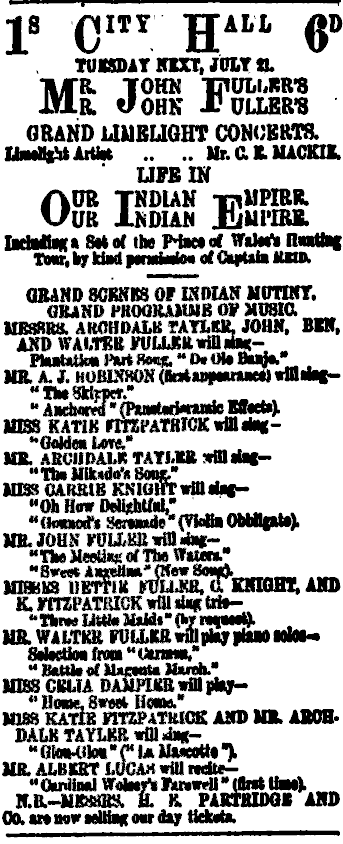
New Zealand Herald, 18 July 1896
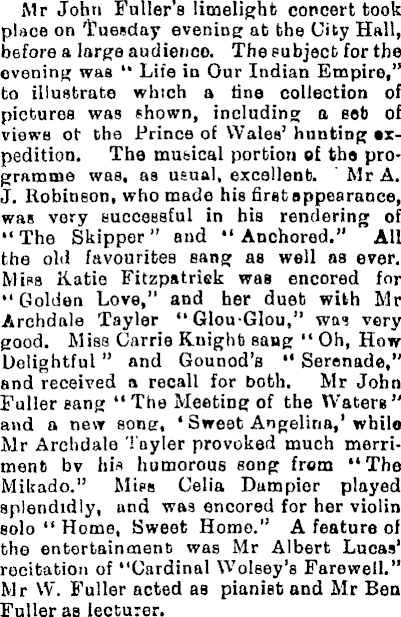
Auckland Star, 23 July 1896
In July 1896 the Fullers introduced a new myriorama in their Grand Limelight Concerts, Life in our Indian Empire to large audiences. Mr. A. J. Anderson made his first appearance singing The Skipper and Anchored, Miss Katie Fitzpatrick was encored for Golden Love and a duet with Mr. Archdale Taylor called Glou-Glou. Miss Carrie Knight sang Oh How Delightful and Gounod’s Serenade. John Fuller sang The Meeting of the Waters and Sweet Angelina. Much merriment was enjoyed with Mr. Archdale Taylor’s humorous rendition of his song The Mikado’s Song and Miss Celia Dampier was encored for her violin solo Home Sweet Home. For the first time Mr. Albert Lucas recited Cardinal Wolsey’s Farewell with Walter Fuller as pianist and Ben Fuller as lecturer.
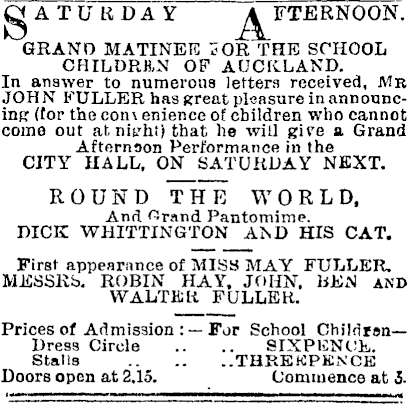
Auckland Star 30 July 1896
The Fuller’s entertainment business was branching out to encompass the ever-popular pantomime shows, so beloved by both the young and the young at heart. For John Fuller, it was a matter of show business, and if he had a theatre he would promote a show, thus matinee shows became a popular feature of both Australian and New Zealand audiences. In fact, it was a clever business, because once inside a darkened theatre, one simply forgot whether it was day or night.
The pantomime Dick Whittington and his Catrecords the first appearance at the age of four of Miss May Fuller. It also included John, Ben and Walter Fuller as well as Robin Hay.
On Saturday 18 July 1896, The Observerwrote that the Fuller’s weekly People’s Popular Concerts the previous Tuesday, presented a Tour Through Picturesque Wales and Windsor Castle, “the numerous views thrown on the screen being beautiful and artistic. Walter and Ben Fuller acted as guides and friendly cicerones describing the scenes with interest. The vocalists were Misses Bertha Roberts and Issey Hart, (both debutantes) Lydia Fuller and Featon, Messrs. John Fuller, Archdale Taylor, Robin Hay and Norman Warren, whilst Mr. Albert Lucas recited “The Man Hunt”, Mr Fuller sang in his usual style two first class Welsh songs, “The Maid of Llangollen” and “Megan’s Fair Daughter” and an extra item, “Ben Bolt.”
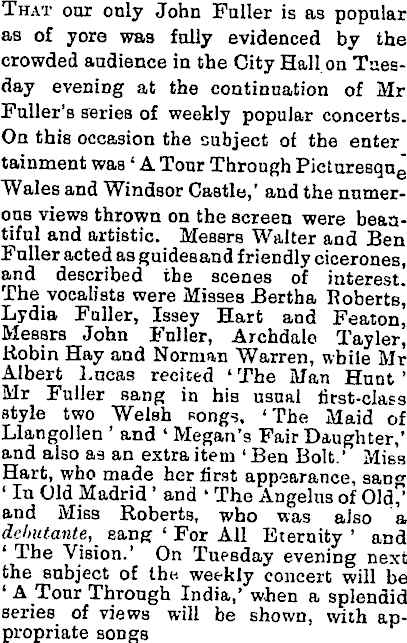
The Observer, 18 July 1896
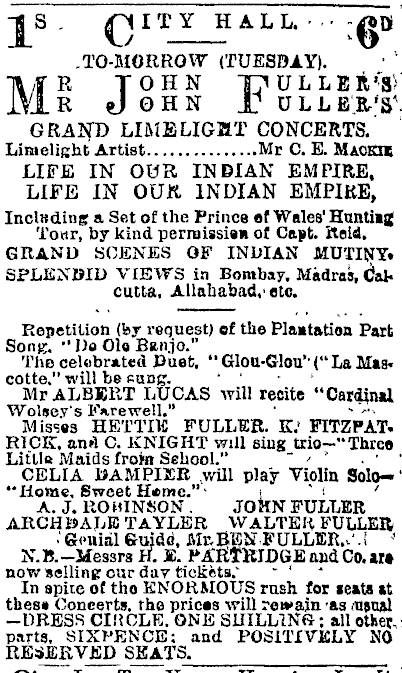
Auckland Star 20 July 1896
Just a week later the lantern show produced “Life in Our Indian Empire” including grand scenes of an Indian mutiny and splendid views of Bombay, Madras, Calcutta and Allahabad.
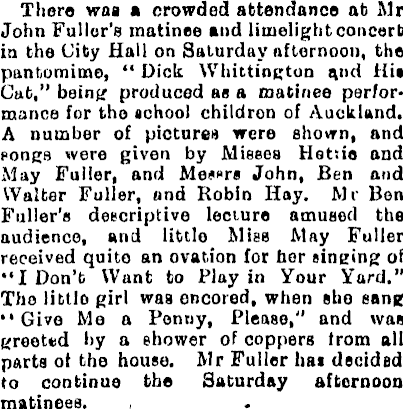
Auckland Star, 3 August 1896
Wonderful reviews were recorded for the Pantomimes and the success from the public’s point of view hailed the Saturday afternoon matinees as a popular event. I am sure John Fuller was pleased to announce they would continue.
The combination of placing advertisements in the newspapers came with the added bonus of wonderful reviews and promotions. Again, the Fullers had found a brilliant formula to promote their theatrical business. Success was coming quickly to this very energetic family.
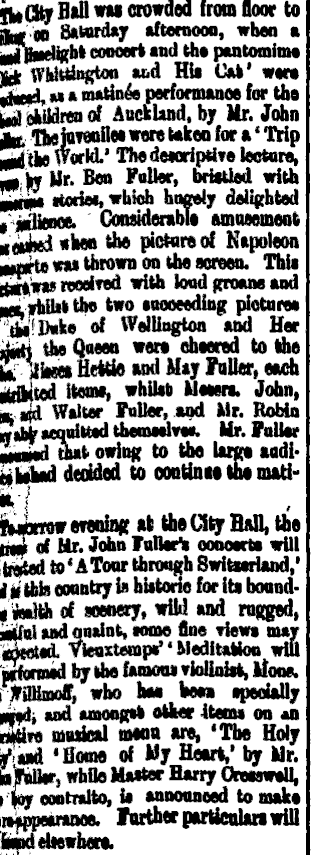
New Zealand Herald, 3 August 1896
The reviewer of the pantomime of Dick Whittington and his Cat is full of praise for the performance of the newest cast member, May Fuller, and also promotes their new concert, A Tour through Switzerland.

Auckland Star 7 September 1896
On 7 September 1896, John Fuller’s Concert series was showing “Beauty Spots of the Globe”, including The Holy Land, Dr. Nansen’s Polar Expedition and Constantinople. John Fuller’s songs that evening were The Picture that is Turned Towards the Wall, Sunshine Above andBen Boltand he also featured in a quartette with his daughter Lydia Fuller, Ella Farrell and Archdale Taylor singing All Good Angels.
The one thing that probably troubled John Fuller was that his shows were very much dominated by the Fuller name and there could have been criticism levelled at them to state that this was just a Fuller Show and lacked depth and substance. John soon came up with a remarkable solution to this perceived problem by giving his children stage names. It only took me a few minutes to work this latest ploy out and it was with much amusement that I collected the next few newspaper clippings from old New Zealand newspapers. I was also at a point in my research where I was getting to know my great grandfather and understanding what was going on in his head. He was a clever showman who was one step ahead of his audiences, with the remarkable cunning of knowing what they wanted and how to keep them entertained and keep them coming back to his new productions.

The Globe, 8 September 1896
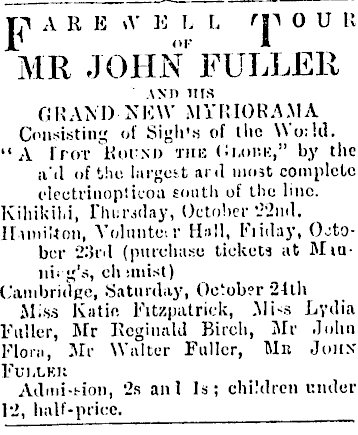
Waikato Argus 20 October 1896
John Fuller presents his “Grand New Myriorama, Consisting of Sights of the World, A Trot Round the Globe”, by the aid of the largest and most complete electrinopticon south of the line.
This was the first time I saw the name Mr John Flora, and I must say I wondered who this new operator of the Fuller myriorama was. Another reviewer soon comes up with another novel name for the Fuller’s machine, the Glechinophion!
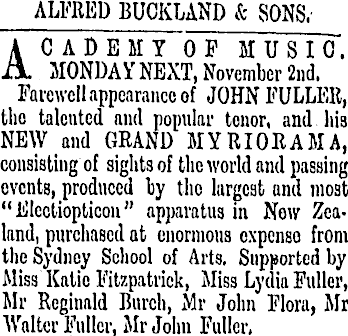
The Argus, 20 October 1896
However the review in the Ohinemuri Gazette, 24 October 1896 was even more exciting when he described the last six months in Auckland for John Fuller. “He has struck oil …His new Myriorama, which was witnessed by close on 50,000 people alone this season is really worth going miles to see.”
The reviewer goes on to describe Walter Fuller as “undoubtedly one of the first performers on the pianoforte in this country” and John Flora and an assistant having control of the Glenchinophion, with the popular tenor John Fuller singing Ben Bolt, Sally in our Alley andThe Death of Nelson.
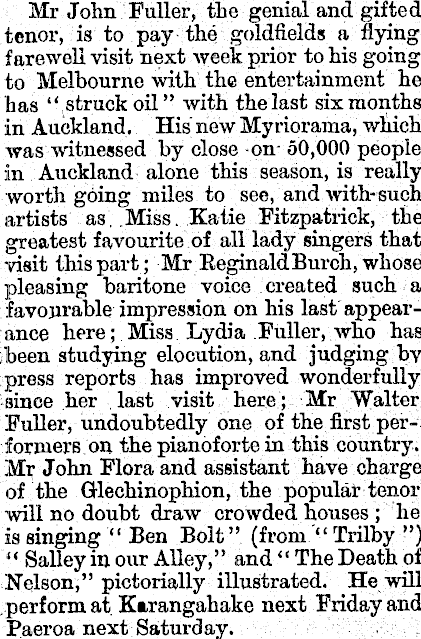
Ohinemuri Gazette, 24 October 1896
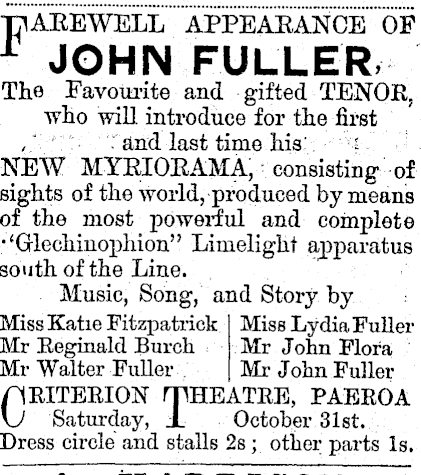
Thames Advertiser, 31 October 1896
I was enjoying my research so much, with each and every new clipping and every new month, there was something novel this talented family was up to. They delighted me with their sense of invention, tireless enthusiasm and their enormous talent, that I hadn’t realised before, which had involved the entire family. The Fullers travelled to Wellington for Christmas in 1896 and again received rave reviews for their concerts. The transition to stage names for Lydia and Hettie occurs in time for their Christmas Concert.
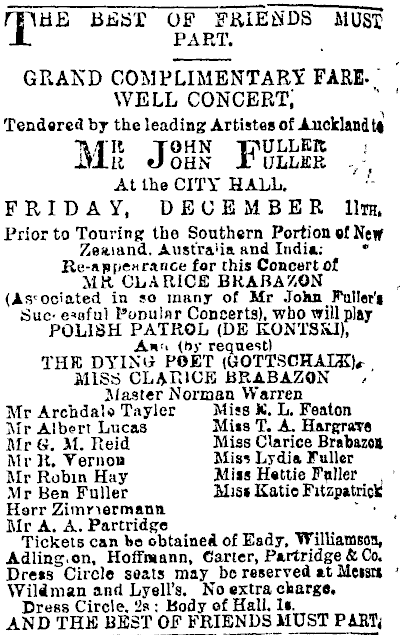
Auckland Star 8 December 1896
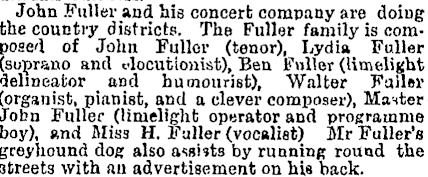
Otago Witness 10 Dec 1896
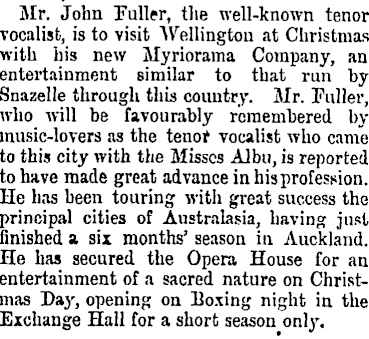
Evening Post 12 December 1896

Evening Post, 19 December 1896
As well as Johnny Fuller becoming John Flora, Lydia Fuller had become Miss Lydia Walter and Hettie Fuller had become Miss Hettie Walden, two interesting stage names. Lydia’s was most definitely chosen for her grandmother Mary Walter’s maiden name. Mary Walter had married Benjamin Richard Fuller, and were John Fuller Snr. parents.
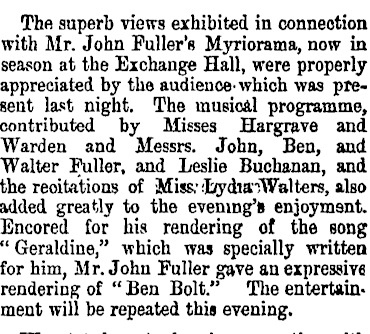
Evening Post 31 December 1896
Following on from the family’s great farewell tour in Auckland and the Fuller’s Christmas and New Year shows in Wellington, John Fuller decided to take the show on the road and in the new year they visited Fielding, Whanganui and Hawara on the lower regions of the North Island. The plan after that was to visit the South Island and in particular John Fuller was keen to return to the Otago peninsula and play in Dunedin.
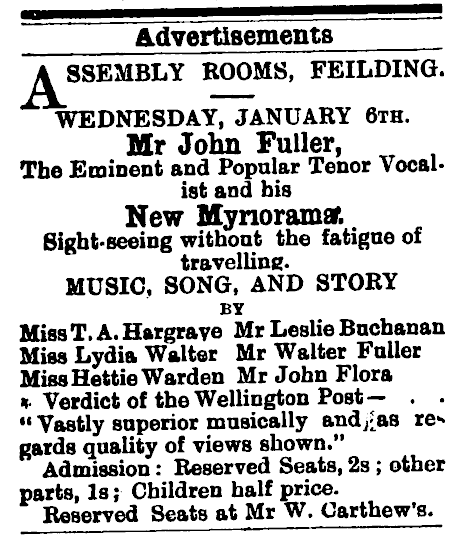
Fielding Star 4 January 1897
The Fielding Star’sadvertisement for John Fuller’s New Myriorama states “sight-seeing without the fatigue of travelling.”
I could also see that the admission charges of 2 shillings for reserved seating, 1 shilling elsewhere and children half price was indeed affordable entertainment for the masses being provided by the Fullers.
This was something my mother, Vena Robson nee Fuller, always used to talk about and she stated to me time after time that she couldn’t understand how free entertainment stumped up by our modern-day state and local government authorities could possibly be successful or properly appreciated and that it would come with a public expectation for free future events and result in government subsidies and grants to musical institutions and organisations that could not make money or profits otherwise. In her opinion, a small charge should always accompany entertainment, even if it was just a coin offering. She was proud that the Fuller family never received, nor had any expectation of government funding for their productions.
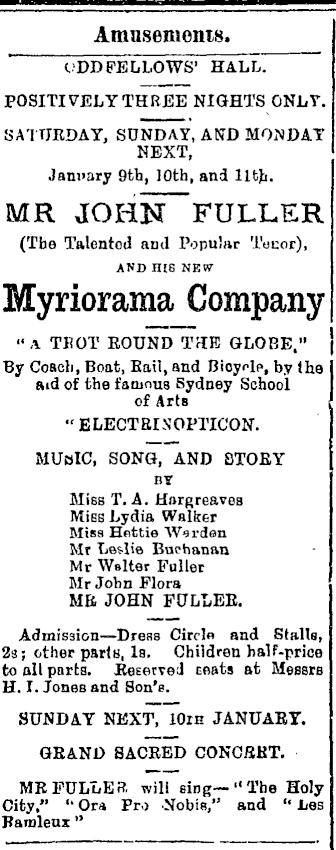
Whanganui Chronicle 7 January 1897
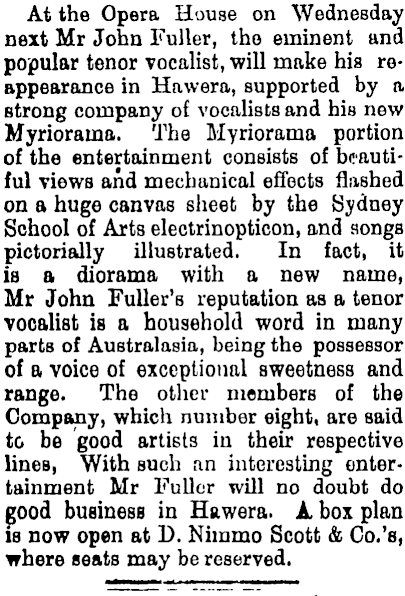
Hawara Star 16 January 1897
It is entertaining to read the information supplied by John Fuller to these journalists for their reviews. Where he got the idea to promote Miss Hettie Warden as a well-known London drawing room entertainer shows John’s marvellous invention and imagination. Perhaps he was thinking back to his own home, and how Hettie could sing to entertain her family?
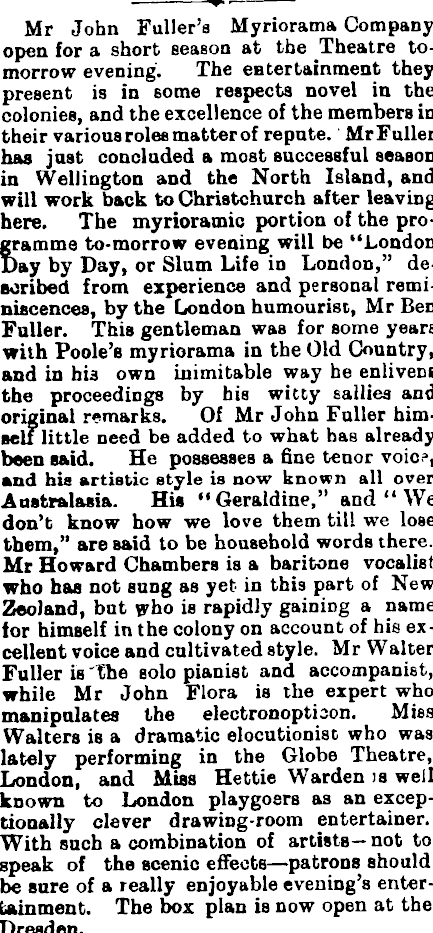
Southland Times 8 March 1897
It is entertaining to read the information supplied by John Fuller to journalists for their reviews. The Southland Times from 8 March 1897 writes about “John Flora, the expert who manipulates the electronopticon.”Where he got the idea to promote his daughter Miss Hettie Warden as “well-known to London playgoers as an exceptionally clever drawing-room entertainer”, shows John’s marvellous invention and imagination. Perhaps he was thinking back to his own home, and how Hettie could sing to entertain to her family when they lived in England!
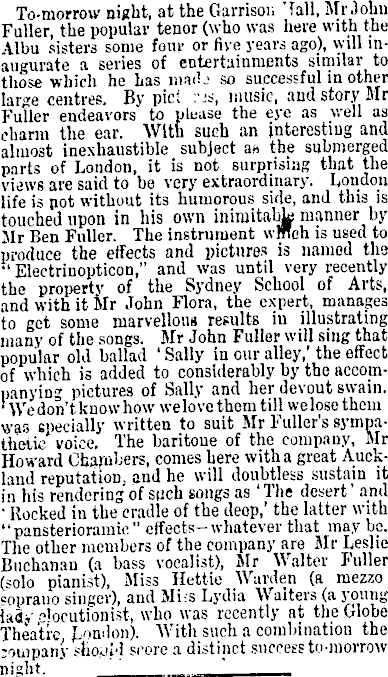
Evening Star 2 April 1897
It can be seen from this last article from the Evening Star, 2 April 1897 that the Fullers are performing at the Garrison Hall in Dunedin have welcomed into their company baritone, Mr. Howard Chambers “who comes here with a great Auckland reputation and will doubtless sustain it his rendering of such songs as “The Desert” and “Rocked in the Cradle of the Deep”. Other members of the company are Mr. Leslie Buchanan, a bass vocalist, Miss Hettie Warden, a mezzo soprano singer, and Miss Lydia Walters, a young lady elocutionist who was recently at the Globe Theatre, London.” The last two singers being John Fuller’s two daughters introduced by their new stage names.
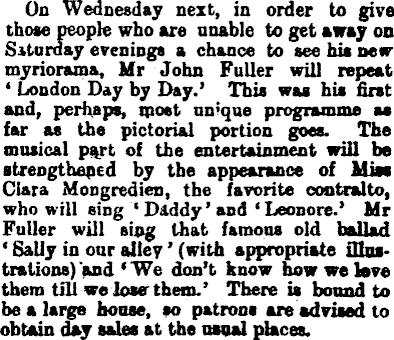
Evening Star Dunedin, 20 April 1897
The myriorama “London Day by Day”, the Evening Star, 20 April 1897 explained that the Fuller’s forthcoming Wednesday evening Concert would repeat the successful previous Saturday night’s entertainment in Dunedin. Ben Fuller would take the audience through a personal experience of his slum life in London and was no doubt entertaining as it was self-deprecating.
The paper states “the appearance of Miss Clara Mongredien, the favouite contralto, who will sing “Daddy” and Leonore” and Mr John Fuller will sing that famous old ballad “Sally in our Alley” (with appropriate illustrations) and “We don’t know how we love them till we lose them.”
John Fuller’s Myriorama, London Day by Day, poster image is courtesy of The Scott Fuller Collection.

Evening Star, Otago, 11 May 1897
The Evening Starwrites that the Fuller Myriorama Company will present a programme entitled “Cathedrals of the World”. “Mr. Fuller has engaged Miss Rose Blaney who will sing “Cavalry” and “The Star of Bethlehem”, both illustrated by pictures and myrioramic effects, as also is Mr. Fuller’s item “Ora pro Nobis “…who will sing (by request),the “Holy City”.
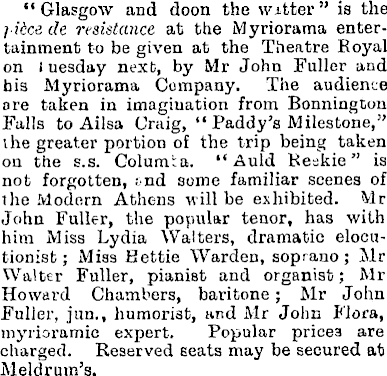
Omaru Mail 16 July 1897
The Fullers by now had been on the road for over 6 months, and worked their way up the coast from Dunedin to Omaru and then returned to Wellington. Ben Fuller was absent from September 1897, because he made a trip back to England to obtain more urgently needed myriorama slides and to recruit new acts for the Fuller’s shows. It was essential that the Fullers keep updating their shows as variety was everything, and new acts were a vital part of their entertainment business. Ben Fuller also investigated the idea of bring a wax works exhibition to New Zealand. These were of tremendous interest to the general public and were very popular. The idea of combining wax works figures and roaming historical figures before the start of their shows was another extension of their entertainment business.
By August the Fullers had returned to Wellington, this time performing at a skating rink, adding another interesting theme to their concerts.
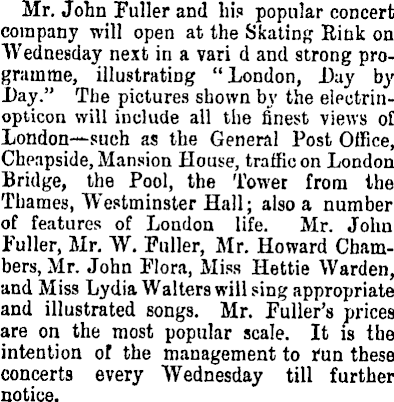
Evening Post 23 October 1897
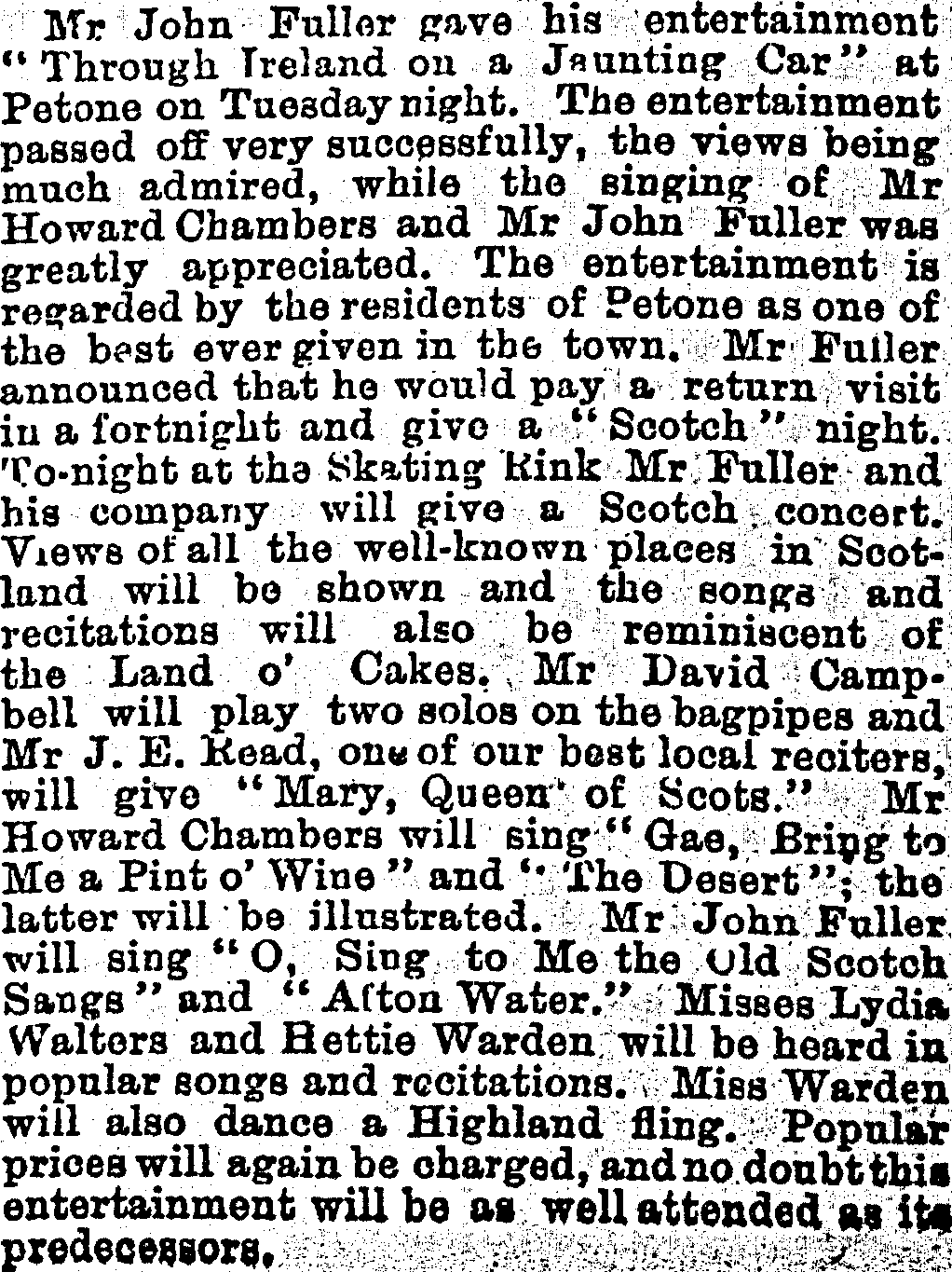
New Zealand Mail, 18 November 1897
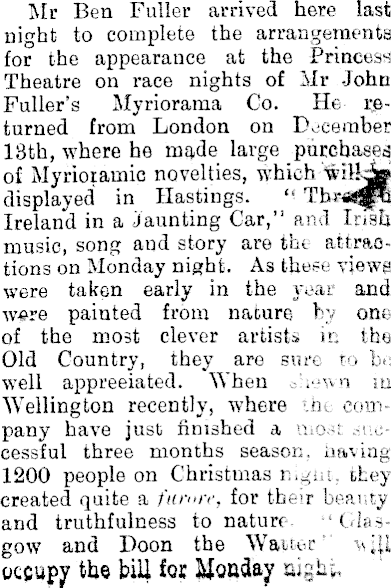
Hastings Standard, 29 December 1897
These newspaper articles describe the new myrioramic delights that Ben Fuller obtained in London including “Through Ireland in a Jaunting Car” with Irish music, song and story including the sights of Kililney (sic), Wicklow, Castle Howard, Kilkenny and Cork. What is amusing is that John Fuller continues his interesting tales and inventiveness to include Professor Malden’s contribution from The London Polytecnic (sic), now Westminster University. Rapid advances in technology resulted in new courses and lecture programs to promote further understanding. John Fuller, on the other side of the world was embracing this new world enthusiastically.
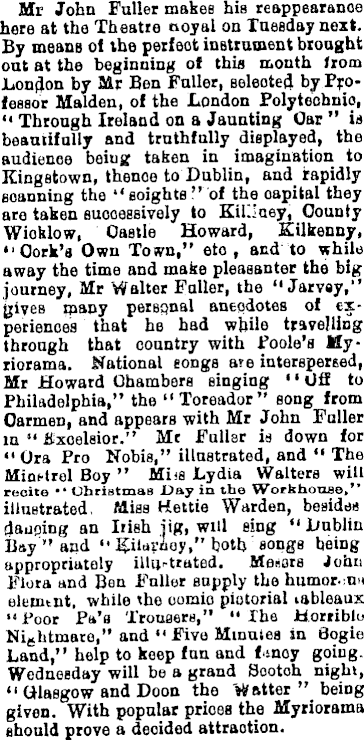
Daily Telegraph 31 December 1897
THE MYRIORAMA
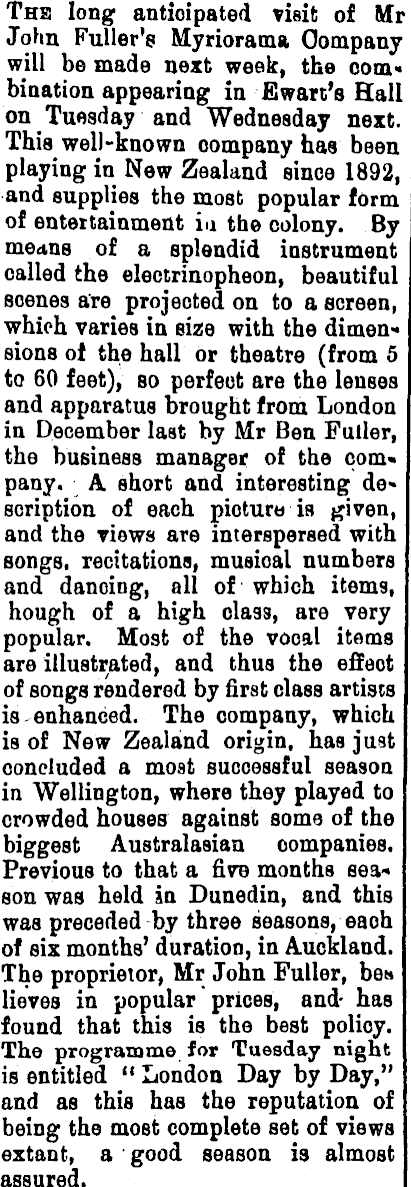
The Myriorama, Malborough Express, 21 January 1898
A wonderful description is included in this article on the Fuller’s Myriorama.
1898 would continue to be another year of great successes with the Myriorama being the major draw card. The Fullers had actually shown some of their “new” myriorama’s to the Wellington and Dunedin audiences first. It was probably more of an experiment to see how receptive the audiences were to change as much as giving his audiences in Auckland a breather for the year 1897 while the Fuller Concerts went on tour.
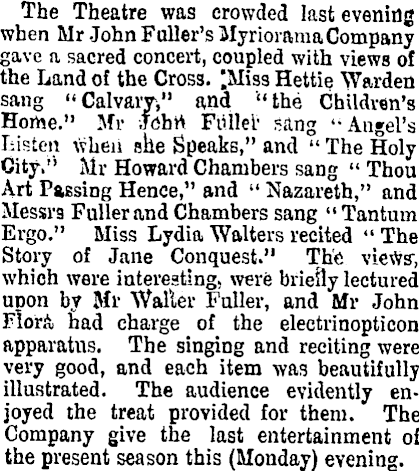
The Nelson Colonist 2 February 1898
Nelson is a town on the most northern part of the South Island of New Zealand. Following on from this town, the Fuller’s next major city they visit is Christchurch.
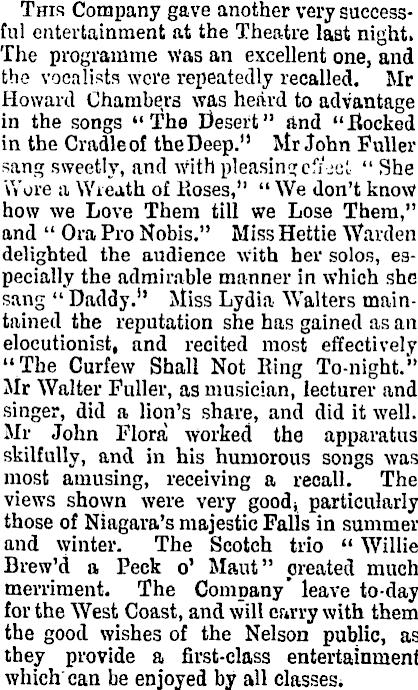
Colonist 8 February 1898
John Fuller’s Company is at Nelson on 8 February 1898. John sings a new song “sweetly and with pleasing effect, “She Wore a Wreath of Roses” and also his signature tune “We don’t know how we love them till we lose them” and “Ora Pro Nobis”… Miss Hettie Warden delighted the audience with her solos, especially the admirable manner in which she sang “Daddy” and Miss Lydia Walters maintained the reputation she has gained as an elocutionist, and recited most effectively “The Curfew Shall not Ring To-night.”
The myriorama effects were particularly well received of Niagara’s majestic falls in summer and winter. John Flora worked the machine well and later was well received for his humorous songs, receiving an encore.
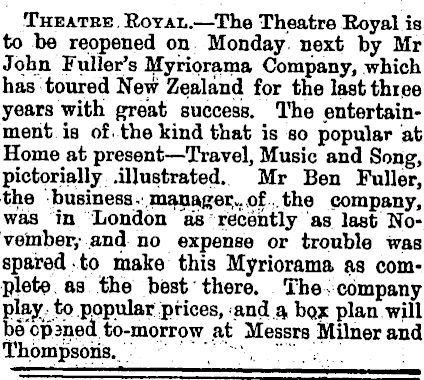
Christchurch Star 20 April 1898
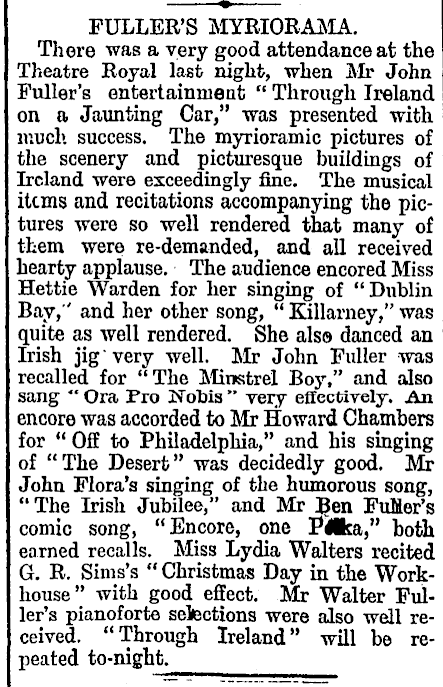
Christchurch Star, 29 April 1898
The Fuller Myriorama Concert continues in Christchurch at the Theatre Royal, the Christchurch Starreports that “The audience encored Miss Hettie Warden for her singing of “Dublin Bay” and her other song “Killarney” was quite as well rendered, she also danced and Irish jig very well. Mr. John Fuller was recalled for “The Minstrel Boy” and also sang “Ora Por Nobis” …an encore was accorded to Mr Howard Chambers for “Off to Philadelphia” and his singing of “The Desert” was decidedly good. Mr John Flora’s singing of the humorous song, “The Irish Jubilee” and Mr. Ben Fuller’s, “Encore one Polka” both earned recalls. Miss Lydia Walters recited G. R. Sim’s “Christmas Day in the Workhouse” and Mr. Walter Fuller’s pianoforte selections were also well received.”

Ellesmere Guardian 8 June 1898
This is a wonderful account of the Fuller’s talented entertainers and even though John Fuller is billed as the “star” there is an even higher acclamation for Howard Chambers with the statement about the best bass voice ever heard in Leeston.
By the end June the Fullers were in Temuka, near Timaru, south of Christchurch for a revisit which proved popular.
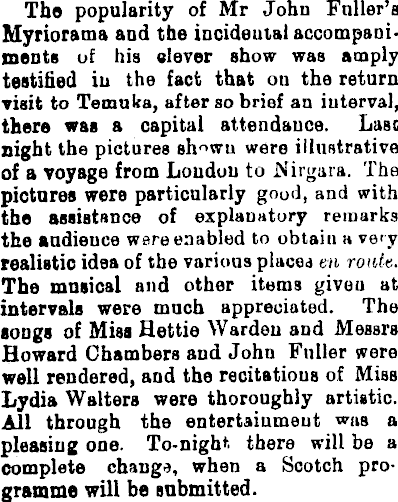
Temuka Leader, 23 June 1898
The Fullers were again working their way down the coast to Dunedin and by the end of June I found newspaper clippings showing that they were pulling in exceptionally large audiences to their Myriorama shows. Also impressive was how incredibly varied the Fuller concerts had become.
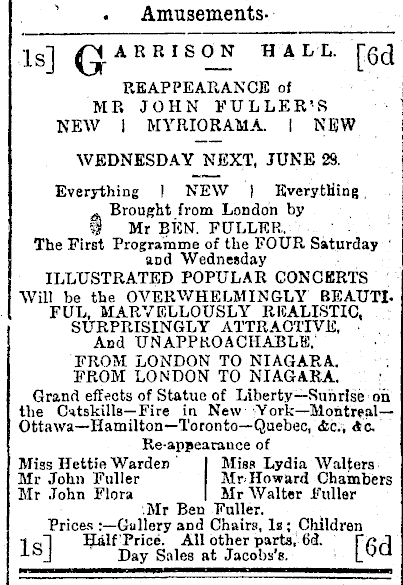
Garrison Hall, Dunedin, Otago Daily Times, 27 June 1898
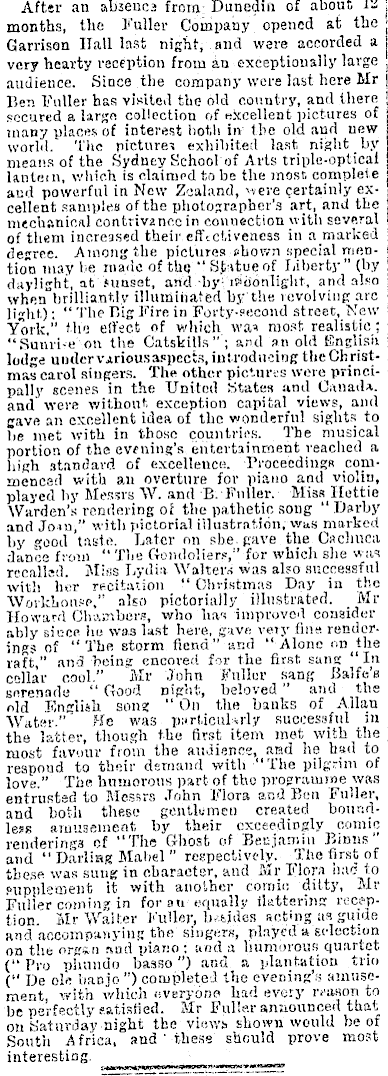
Otago Daily Times, 30 June 1898
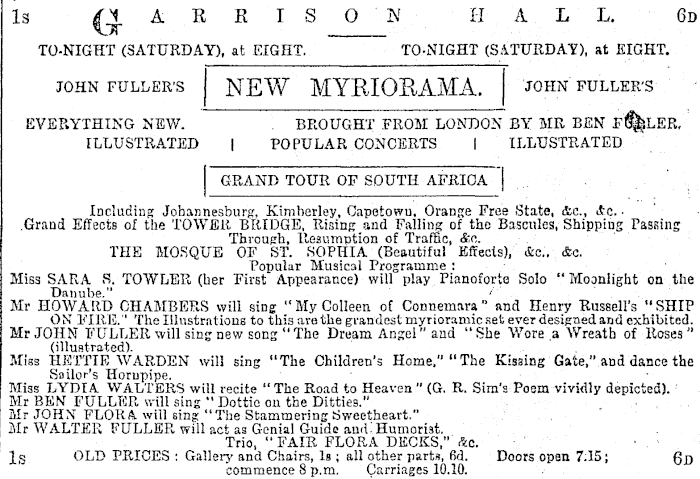
Otago Daily Times, 2 July 1898
This is an interesting advertisement in theOtago Daily Times2 July 1898, for John Fuller’s New Myrioramaat Dunedin’s Garrison Hall, in which Ben Fuller is promoted as having bought this new illustrated concert back from London for New Zealand audiences.
The myriorama is explained as a Grand Tour of South Africa which includes Johannesburg, Kimberley, Capetown and Orange Free State; Grand Effects of the Tower Bridge rising and falling and The Mosquie of St. Sophia.
The popular musical programme featured Miss Sara E. Towler in her first appearance playing a pianoforte solo, Moonlight on the Danube, Mr Howard Chambers singing, My Colleen of Connemara and Ship on Fire.
John Fuller sings a new song, The Dream Angel and She Wore a Wreath of Roses, Hettie Warden sang The Children’s Homeand The Kissing Gate and Lydia Walters recited The Road to Heaven. Ben Fuller sang Dottie on the Ditties, John Flora sang The Stammering Sweetheart and Walter Fuller was the announcer and humorist.
JOHN FULLER’S EXCURSIONS
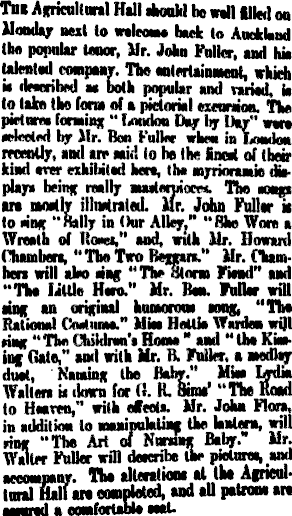
New Zealand Herald 17 September 1898
September heralded a welcome back to Auckland for John Fuller and his theatrical company. They had been touring solidly for two years and although probably exhausted by this effort, it had certainly paid off financially for the Fullers.
The Agricultural Hall was well filled on 17 September 1898 to see the new myriorama, “London Day by Day” recently selected by Mr. Ben Fuller, when in London. It was another family affair, John Fuller sang Sally in Our Alley and She Wore a Wreath of Roses, Howard Chambers sang The Storm Fiend and The Little Heroes. Ben Fuller sang an original and humorous song, The Rational Costume, with Hettie Warden singing The Children’s Home and The Kissing Gate, later the two siblings sang the medley duet, Naming the Baby. John Flora in addition to manipulating the lantern, sang The Art of Nursing Baby, Lydia Walters recited George Robert Sim’s poem, The Road to Heaven and Walter Fuller was interlocutor.
The next few years see the Fullers move out of New Zealand for a short time while they take their show on the road to Australia. Again, they are overwhelmed by the successes of their shows and the reception of the audiences. The newspaper attention must have been very flattering and turned them into what we now call celebrity status; whereby the journalists recorded their every move.
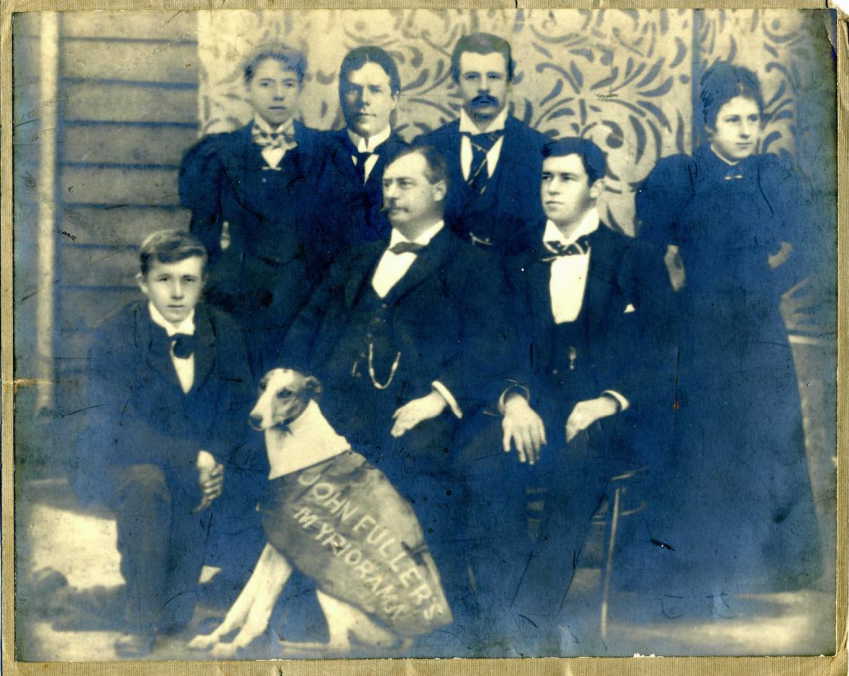 The stars of Fuller’s Myriorama Company. Sitting, left to right, Johnny Fuller, Roto the Greyhound, John Fuller Snr, Howard Chambers, Standing, left to right, Lydia Fuller, Walter Fuller, Benjamin Fuller and Hettie Fuller. Image courtesy of Emily Dickson, a grand-daughter of May Fuller.
The stars of Fuller’s Myriorama Company. Sitting, left to right, Johnny Fuller, Roto the Greyhound, John Fuller Snr, Howard Chambers, Standing, left to right, Lydia Fuller, Walter Fuller, Benjamin Fuller and Hettie Fuller. Image courtesy of Emily Dickson, a grand-daughter of May Fuller.
To celebrate the return of Fuller’s Myriorama Company back to Auckland, John Fuller organized a photograph to mark the occasion. Roto, the greyhound, a favourite pet of the Fuller family, famously patrolled the pavement, outside the Auckland Opera House, carrying an advertisement for “John Fuller’s Myriorama” on his jacket, became a star in his own right, helping to fill the theatre to capacity.
Matilda Emily “Ma” Fuller was expecting her second baby, and on 22 October 1898 Raymond Gerald Fuller was born. John Fuller proudly announced the birth in the newspaper.
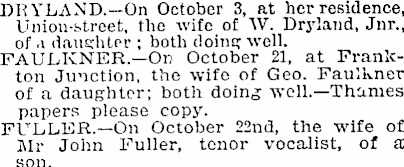
Auckland Star 27 October 1898
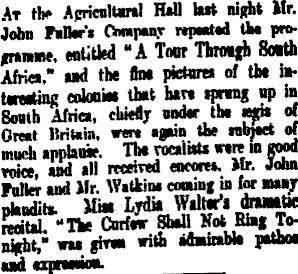
New Zealand Herald, 17 November 1898
Mr. John Fuller’s Company presented A Tour Through South Africa with vocalists Mr. John Fuller, Mr. Watkins and Miss Lydia Walter’s dramatic recital The Curfew Shall Not Ring Tonight.
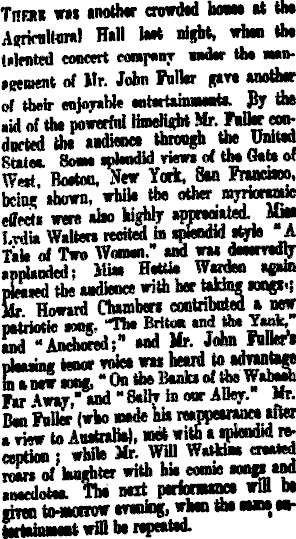
New Zealand Herald, 22 November 1898
A week later Mr. John Fuller’s Company gave an enjoyable evening of powerful limelight entertainment conducting the audience through the United States, with splendid views of Boston, New York and San Francisco. Lydia Walters recited A Tale of Two Women, Howard Chambers sand The Briton and the Yank and Anchored and Mr. John Fuller sang On the Banks of the Wabash Far Away and Sally in Our Alley.
My next chapters, The Fuller Fortunes 1899-1904, Fuller’s Earth 1905-1910, The Fuller Family Fame, 1911 – 1913 and The Fuller Family Empire 1914-1930, willcontinue the story of the increasing fortunes of the Fullers, highlighting their world of entertainment, their marriages, world tours, personal tragedies, a divorce scandal that would create a publicity furore, a libel and a copyright case that hit the headlines in both New Zealand and Australia, as well as the Famous “Pig’s Whistle Case” in Auckland in 1913, when John Fuller Snr. sued the Triad newspaper for defamation.
Virginia Rundle
8 November 2016, updated March 2019
Bibliography:
Trove Digitised Newspapers
Papers Past New Zealand
Actor’s Blood, Alistair Duncan
Johnny Fullers Scrapbook
Scott Fuller memorabilia and photographs
Australian National Gallery
Photographs courtesy of Emily Dickson


